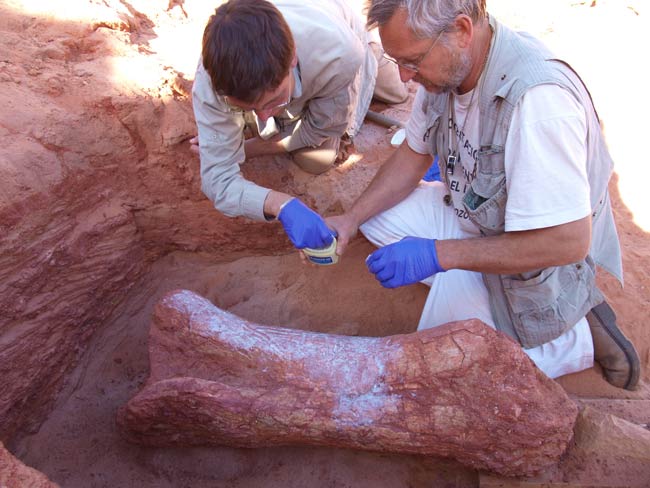Giant Dinosaur Fossil Found in Sahara Desert

Paleontologists claim they have unearthed a new type of pterosaur and a previously unknown sauropod dinosaur in the Sahara Desert.
The probable pterosaur was identified by a large fragment of beak from the giant flying reptile, and the probable sauropod, an herbivore, was represented by a long bone measuring more than a yard long, indicating an animal nearly 65 feet (20 meters) in length. Now extinct, both would have lived almost 100 million years ago.
The fossils were found in southeast Morocco, near the Algerian border, during a month-long expedition.
"Finding two specimens in one expedition is remarkable, especially as both might well represent completely new species," said University College Dublin graduate student Nizar Ibrahim, who led the expedition and was accompanied by Moroccan scientists Samir Zouhri and Lahssen Baidder as well as University of Portsmouth researchers Darren Naish, Robert Loveridge, David Martill and Richard Hing.
Ibrahim will undertake a detailed analysis of the sauropod bone, which he and Martill expect is a new species and genus of sauropod. He will also examine the pterosaur remains, which are particularly uncommon because their bones, optimized for flight, were light and flimsy and seldom well-preserved.
"Most pterosaur discoveries are just fragments of teeth and bone so it was thrilling to find a large part of a beak, and this was enough to tell us we probably have a new species," Ibrahim said.
The team traveled more than 5,000 miles by Land Rover in an overland trip that went through the Atlas Mountains. Sandstorms and floods challenged the team. For instance, having discovered the giant sauropod bone, they had to return to the nearest town to get more water and plaster with which to protect the fossil, a trip which involved crossing flooded rivers at night with water coming in through the vehicle's doors.
Sign up for the Live Science daily newsletter now
Get the world’s most fascinating discoveries delivered straight to your inbox.
At one point during the fieldwork, heavy rain in the Atlas Mountains flooded the Ziz River. To retrieve the bone, the team had to manhandle the fossil in its plaster jacket down the side of a mountain, clearing thousands of stones to make a safe path to carry it on a wooden stretcher.
"There was a point when we wondered if we would make it out of the desert with the bone, but we had worked so hard to find it so there was no way I was leaving it behind. It took us five days to get the bone out of the ground and down the mountain — and that was not the end of our problems," Ibrahim said.
Martill, one of the Portsmouth researchers, added: "When we had managed to get the bone in the Land Rover, the extra weight meant we kept sinking in the sand dunes and on several occasions everybody except the driver had to walk while we negotiated difficult terrain. Our journey home was equally eventful. While crossing the Atlas Mountains, we got caught in a snowstorm and total whiteout. But it’s all been worth it."
The team was also excited to discover some rare dinosaur footprints, including some that record several animals walking along the same trail, as well as hundreds of dinosaur teeth, bits of giant crocodiles and some probable new species of fish.
Ibrahim said: "It's amazing to think that millions of years ago the Sahara was in fact a lush green tropical paradise, home to giant dinosaurs and crocodiles and nothing like the dusty desert we see today. Even to a paleontologist dealing in millions of years, it gives one an overwhelming sense of deep time."
The fossils will return to Morocco for display after study in Dublin, said Zouhri, a geologist at the Université Hassan II in Casablanca.
- Gallery: Dinosaur Art
- Vote: Dinosaurs That Learned to Fly
- All About Dinosaurs











